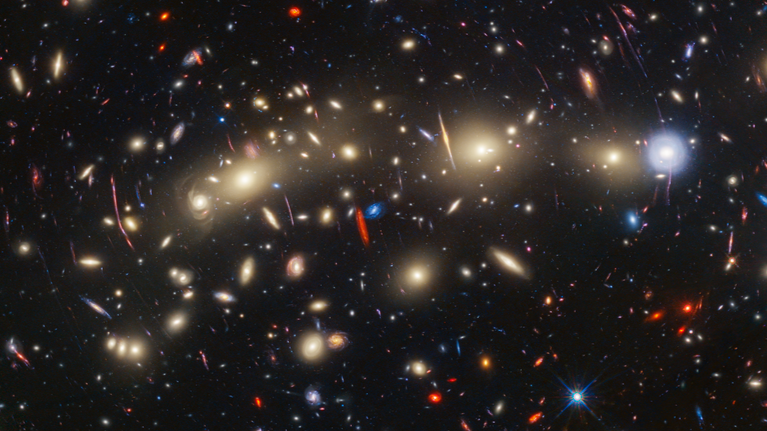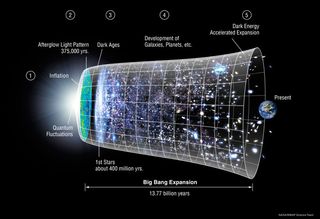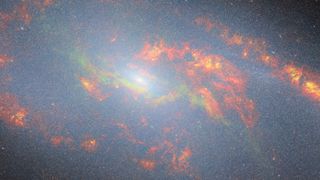
‘Our understanding of the universe may be incomplete’: James Webb Space Telescope data suggests we need a ‘new cosmic feature’ to explain it all (Image Credit: Space.com)
New observations from the James Webb Space Telescope (JWST) have corroborated data from its predecessor, the Hubble Space Telescope, to determine something is missing from our recipe of the cosmos.
The JWST conducted its largest survey yet of the accelerating expansion of the cosmos as scientists attempt to discover why the universe is expanding faster today than our picture of its infancy, billions of years ago, says that it should. Currently, scientists theorize that the accelerating expansion is caused by a placeholder element, “dark energy,” but they really need to know what dark energy actually is before a conclusive explanation can be found.
JWST’s survey served to cross-check observations made by Hubble that suggested a discrepancy in measurements of the rate of cosmic expansion, known as the Hubble constant. This issue has been termed “Hubble tension,” and these new findings show that errors in data from the long-serving space telescope of the same name are not responsible for it.
As the Hubble tension can’t be accounted for by either our best models of the universe or errors in Hubble measurements, an extra ingredient still seems to be needed in our cosmic recipe.
“The discrepancy between the observed expansion rate of the universe and the predictions of the standard model suggests that our understanding of the universe may be incomplete,” team leader Adam Reiss, an astrophysicist at Johns Hopkins University, said in a statement. “With two NASA flagship telescopes now confirming each other’s findings, we must take this [Hubble tension] problem very seriously — it’s a challenge but also an incredible opportunity to learn more about our universe.”
In 2011, Reiss won the Nobel Prize in Physics for the discovery of dark energy, a mysterious force that drives the acceleration of the expansion of the universe. This new research builds upon that Nobel Prize-winning work.
What is the Hubble tension?
Because the expansion of the universe works on very large scales, Hubble tension isn’t something that affects us in our everyday life or even on scales of the solar system or even the Milky Way.
This discrepancy becomes really problematic when considering the distances between galaxies and the larger structure of the universe. That means cosmologists can’t really understand the evolution of the universe until they know what the cause of the Hubble tension.
The Hubble tension arises from the fact that there are two ways to calculate the Hubble constant.
Scientists can use things like distances to Type Ia supernovas or variable stars, which they call “standard candles,” to measure the distances from Earth to the galaxies that host them and then determine how rapidly these galaxies are moving away.
They can also use our models of cosmic evolution to “wind forward” the universe and calculate what the Hubble constant should be today.
However, when measurements of the Hubble constant are taken in the local universe, they are higher than the value predicted by working forward using the best model we have for cosmic evolution, the Lambda Cold Dark Matter (LCDM) model, also known as the Standard Model of Cosmology.
The LCDM-based method gives a value for the Hubble constant of about 152,000 miles per hour per megaparsec (68 kilometers per second per megaparsec, or Mpc), while measurements based on telescope observations regularly give a higher value of between 157,000 mph per Mpc to 170,000 mph per Mpc (70 to 76 km/s/Mpc).
An Mpc is equivalent to 3.26 light-years or 5.8 trillion miles (9.4 trillion kilometers), so this is a huge discrepancy, one which scientists feared was too large to be explained by uncertainties in observations.
Looks like they were right!
Hubble was right!
To confirm the findings of Hubble, Reiss, and colleagues turned to the largest sample of data collected by the JWST during its first two years of operations, which came from two different projects.
To measure the Hubble constant, they used three independent methods to determine the distance to other galaxies. First, they used so-called “Cepheid variables,” pulsating stars considered the gold standard for measuring cosmic distances. The team then cross-checked this with measurements based on carbon-rich stars and the brightest red giants across the same galaxies.
The team particularly honed in on galactic distances measured by Hubble.
The team’s research with the JWST covered about a third of the full sample of galaxies as seen by Hubble using the galaxy Messier 106 (M106), also known as NGC 4258 and located around 23 million light-years away in the constellation Canes Venaticias, a reference point.
This not only helped them produce the most precise local measurements of the Hubble constant to date, but it also independently verified that Hubble’s distance measurements were accurate.
The galaxies observed by the JWST yielded a Hubble constant of around 162,400 mph per Mpc (72.6 km/s/Mpc), nearly identical to the value of 162849 mph per Mpc (72.8 km/s/Mpc) found by Hubble for the same galaxies.
This eliminates the possibility that the Hubble tension is just an artifact arising from significant bias in the long-serving space telescope’s measurements.
“The JWST data is like looking at the universe in high definition for the first time and really improves the signal-to-noise of the measurements,’’ team member and Johns Hopkins University graduate student Siyang Li said.
Of course, this means there is still a problem of Hubble tension that needs to be tackled. Because the expansion of the universe works on very large scales
Johns Hopkins cosmologist Marc Kamionkowski, who was not involved with this study, thinks that solving the Hubble tension requires a new element to our models of the universe. He has an idea of what this element may be.
“One possible explanation for the Hubble tension would be if there was something missing in our understanding of the early universe, such as a new component of matter — early dark energy — that gave the universe an unexpected kick after the Big Bang,” Kamionkowski said in the statement. “And there are other ideas, like funny dark matter properties, exotic particles, changing electron mass, or primordial magnetic fields that may do the trick.
“Theorists have license to get pretty creative.”
The team’s research was published on Monday (Dec. 9) in the Astrophysical Journal.







